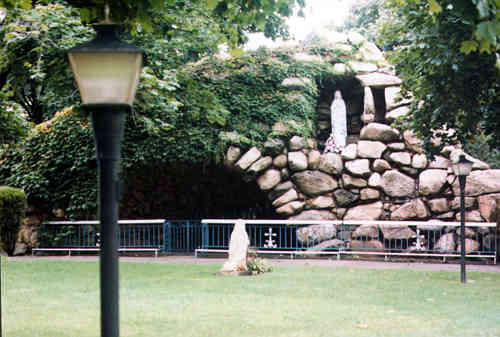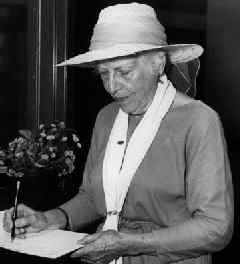
A Cave of Candles / by Dorothy V. Corson

Chapter 2

A Phone Call From a Stranger
After my initial contact with Brother James in 1978, and the receipt of his envelope of Grotto literature, another event-filled thirteen years went by without any additional information coming to light. Then, in the summer of 1991, over a quarter of a century after my first visit to the campus, I received a chance phone call from a stranger.
Our conversation reawakened in me the remembrance of that long ago wish I'd left at the Notre Dame Grotto. It planted me on a path that would prompt me to hunt for my own answers to those long unanswered questions. In the process, I found myself in out-of-the way places, learning new skills and meeting interesting people I would never have known otherwise.
Reliving many of those events for this narrative has brought to mind the words of Mary McDonnell, an actress. Her thoughts spoke to my own regarding such chance circumstances and how they can be turning points in our lives. She put it this way:
In my experience, a real life doesn't occur through a plan, but through looking the other way and having an important thing suddenly presented -- whether it's tragic or extraordinarily wonderful. That seems to me where life starts to really be lived. . . . Before, . . . my engine wasn't running. I was having a great life, but my brain wasn't moving at a very fast clip, I wasn't inspired. . . . The process . . . forced me to connect with who I was, with me inside. . . . The lightning struck . . . .(5)
I feel blessed to have experienced that kind of life-changing sensation more than once in my life.
That "something important suddenly presented," for me, began very innocently and in a most unlikely way. The stranger on the phone introduced herself as Mary Kintz and related this experience to me. She had been at St. Stanislaus Church for a special celebration, happened to view the Grotto and the plaque there, and was surprised to see what she thought was my brother's name on it (the same as my father's). She said she recognized it as the name of a man to whom her husband had sold six acres of land some 25 years before. That she ran into him infrequently, and wondered what his connection was with the St. Stan's Grotto.

Impressed with it, she said she called immediately to ask him about it. He told her the grotto was built by his father. It was the first job he'd worked on as an apprentice mason, and it was his father's name on the plaque. "Call my sister," he said, "she put the plaque there and she can tell you more about it."
I explained briefly the circumstances surrounding the St. Stan's Grotto. How Father Jan and I had placed the bronze plaque there on a huge stone in 1972. Whereupon, she spoke of her special devotion to Mary and her avid interest in anything connected with her.
Interested, myself, in the history of the six acres of land my brother had purchased from them, we fell into a conversation about it. It is located within a mile of Notre Dame. She explained how eighty acres of land, which had included my brother's six acres, had been passed down in her husband's family since 1891. "I have the family genealogy," she said, "since you live near the land surrounding Juday Creek and Notre Dame, I'm sure you'd find it interesting reading." We arranged to meet on my usual Friday visit at Holy Cross House, the retirement home for priests on campus, a place she often went for mass and a place I still visit regularly since Father Jan's death. We had a pleasant get-acquainted visit and I left with the copy of her family genealogy.
It laid unopened on my chair-side table for several days before my conscience prodded me to read it and return it to her. It was not a lengthy genealogy but rather a family tree with a few items of personal interest mainly to family members. I had gotten no further than the second paragraph when this sentence jumped out at me. "Peter Kintz and his sons took rocks from their farm and built the Notre Dame Grotto!" How strange, I thought, after almost giving up, to have a vital clue land in my lap, in such an unexpected fashion, and again, through a total stranger. So very like my experience with St. Stan's Grotto.
A favorite saying rebounded in my thoughts: "When God wants something done -- He sends someone." I have always believed that if a problem or situation lands in my lap it's a part of my bundle and I should do whatever I can to take care of it. Was this the "green light" I'd been waiting for all these years, the push, I needed to seek the proof myself?
Knowing that legal records can have errors and information passed on, even among family members, can sometimes be recorded inaccurately, I wondered if the words were correct. Had the Kintz family actually built the Grotto or had they helped build it?
When I returned the genealogy and questioned her about this item she told me the story had been passed on in the family from generation to generation. However, she wasn't quite sure whether it had been correctly interpreted by the family member who compiled it. She said it might have been "helped build" rather than "built" since it was a common practice in those days for area farmers to pitch in when something special was going on at the campus. She said according to family legend, they had also helped hoist the statue to the Dome of the main building when the new building was finished after the fire. It did sound reasonable. After all, in those days farmers were skilled at carpentry and stone masonry in building barns and stone foundations.
Somehow, that question "built or helped build?" sparked my curiosity. It was enough to spur me to make an attempt to prove or disprove that statement. If I couldn't prove they had built it, perhaps, I could prove who did and how they had helped. Nobody else, apparently had thought to trace the origins of the Grotto. Why not give it a try myself, while there might still be people around who could supply the answers to those long unanswered questions?